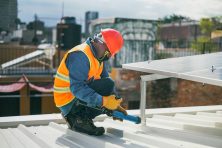I Made $16,000 Tax-Free Flipping a Condo, Thanks to This IRS Loophole…

My wife and I recently made $16,000 selling our condo, and we won’t be paying taxes on a cent.
Next year we might sell our current home for a profit, and we’ll again pay no capital gains tax. How can we do that?
The IRS allows you to exclude a gain of up to $250,000 ($500,000 if you are married and file jointly) on the sale of your primary residence from taxable income if you’ve lived in it for at least two of the past five years. We lived in the condo for 26 months, so we qualified.
“The 24 months of residence can fall anywhere within the 5-year period. It doesn’t even have to be a single block of time. All you need is a total of 24 months (730 days) of residence during the 5-year period.”
It gets more complicated if you rent out the home during that time (you “recapture” any depreciation claimed and pay taxes on that part).
But here’s the short version: If you live in your house for at least two years and sell it, your entire profit is tax-free.
We’ll get back to that in a moment, but first let’s look at an important question…
Is Your Home an Investment?
A home isn’t an investment, because it doesn’t generate income or spendable capital gains, Robert Kiyosaki says in Rich Dad, Poor Dad.
Your house generates expenses, and if you sell it after its value rises, you’ll probably buy another house that costs as much or more. Long term, home values don’t rise faster than inflation.
However, there are some ways to turn a home into an investment. For example, you could rent rooms in your house, which is how I paid off my first mortgage.
Also, there are “make-money investments and save-money investments,” Jennifer Abel points out on Mainstreet.com, A house may not generate income, but if you buy right, you save more money over the years than renting.
So your home can be an investment, and we’re going to add one more way to make it into one…
The Flip Your Home Plan
The home sale capital gains exclusion makes it possible to buy a fixer-upper, live in it while you make repairs and improvements and sell it for a profit without paying a penny in taxes.
Theoretically, you can do this every two years.
Realistically, it takes time to sell a home, and you have to wait two years from the date of sale to claim your next exclusion. Plus, you might not get everyone in the family onboard for the move-every-two-years plan.
But you could at least do this a few times as a way to boost your retirement savings or pay for big vacations.
The key is to understand how to flip a fixer-upper. You have huge advantages when flipping your own home, because there’s no rush.
Since you’re living in your flip, you don’t have holding costs eating into profits, and you would otherwise have to pay housing bills somewhere. But you still have to calculate properly to make your profit.
Making the Calculations
Forget appreciation.
If home prices go up, great, but that still means paying more for the next house you live in, so that’s not really where you make a profit.
Estimate your gain based on the increase in value from the planned repairs and improvements. To calculate that when looking at a potential home, start with the end in mind.
Make a list of what needs to be done and determine what price the house should sell for when you’re finished. Use the “recently sold” tools on websites like Trulia to find nearby homes for comparison. County property appraiser websites often have publicly available information, as well.
If you’re still not sure about values, ask a good real estate agent for help, but make sure he or she has worked in that part of town.
Once you have your projected sale price (based on today’s values), estimate your renovation costs for the property, including holding costs if you can’t move in right away.
Then estimate the buying and selling costs. For the latter, you might just use a figure of 10% of the sale price, which should be enough to cover closing costs and the real estate commission.
Finally, decide what level of profit makes it worthwhile.
Once you have those numbers, you can base your offer on the following formula:
(Projected sale price) – (all costs and profit) = (the most you can pay for the house)
For example, if you want to make $20,000, and you see the renovated house will sell for $160,000, the calculation might look like this:
$160,000 – $20,000 (profit) – $16,000 (transaction costs) – $12,000 (renovation costs) = $112,000
That’s the highest price you can pay, so start with a lower offer. If you get the house, you have at least two years to complete all of the work, which brings us to one more question…
Should You Do the Work Yourself?
I’m not all that mechanically inclined, but in recent years I’ve done everything from painting our homes inside and out to replacing washing machine water lines inside a wall (and repairing the wall afterward).
But there are things I won’t try on my own. For example, I’ll replace electrical outlets, but I won’t put in new electrical lines.
You don’t have to do any of the work yourself. Just be sure your repair and improvement estimates include using contractors.
If the numbers don’t work, walk away. There are other houses to buy.
You’ll probably do best by doing some work yourself and paying professionals for other tasks. I’ve learned that painting is not difficult, so doing it yourself will save you a lot of money.
If the project is something that requires a permit, I like to pay a contractor. Be careful and check out the contractor before signing anything.
Big Tip: Walk through the home with a contractor before buying it.
My wife and I did this with a condo we flipped (we didn’t live in it), and he was able to tell us how to save money doing our own repairs. He also estimated what it would cost for the work he eventually did for us.
Making More Money
Here are two ways to boost profits when flipping homes:
Move More Often
If you want to cash in on tax-free profits, you need to move as close to every two years as you can.
For example, list your home for sale after living in it for about 21 to 22 months. By the time you close the sale, you might be just past the 24-month requirement.
Aim for Higher Appreciation
You don’t normally find a profit in rising prices, since the the price of the next home you buy will also have risen.
But homes in some areas appreciate faster than others.
Use online resources like NeighborhoodScout to identify areas where homes are appreciating the fastest, and buy in one of those neighborhoods.
Your Turn: Would you consider turning your homes into investments by flipping them and moving every few years?
Disclosure: We have a serious Taco Bell addiction around here. The affiliate links in this post help us order off the dollar menu. Thanks for your support!
Steve Gillman is the author of “101 Weird Ways to Make Money” and creator of EveryWayToMakeMoney.com. He’s been a repo-man, walking stick carver, search engine evaluator, house flipper, tram driver, process server, mock juror and roulette croupier, but of more than 100 ways he has made money, writing is his favorite (so far).














